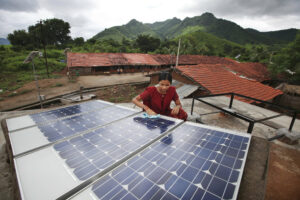
The fact that oil is a “finite” material is not a problem…Every material is finite. Life is all about taking the theoretically finite but practically limitless materials in nature and creatively turning them into useful resources. The fossil fuel industry does it, the “renewable”—actually, the “unreliable”—energy industry doesn’t. End of story.”
Fossil Fuels (coal, oil, petroleum, and natural gas) are originally formed from plants and animals that lived hundreds of millions of years ago and became buried deep beneath the Earth’s surface. These then collectively transformed into the combustible materials that we use today for fuel. The earliest known fossil fuel deposits are from about 500 million years ago, when most of the major groups of animals first appeared on Earth. The later fossil fuels, such as peat or lignite coal (soft coal), began forming from about five million years ago.
Currently, we are (over)dependent on fossil fuels to heat our homes, run our cars, power our offices, industry and manufacturing, and respond to our insatiable desire to power all of our electrical goods. Nearly all of the energy needed to meet our demands – 80 percent of global energy – comes from burning fossil fuels. At the current rate of global energy demands, fossil fuels cannot replenish fast enough to meet these growing needs. The (over)consumption of these non-renewable fuels has been linked to the emission of greenhouse gases and pollutants into the atmosphere – the leading cause of global warming and climate change.
In Ireland, for example, our energy consumption from fossil fuels was 89% in 2013. Our highest demand for fossil fuel energy over the last 51 years was experienced during the period of high growth under the ‘Celtic Tiger’ (2004), where we required 93.39%. The lowest energy consumption value (67.24%) was in 1960, more than half a century ago! Ireland is ranked 46th out of 136 countries in its fossil fuel energy consumption. That’s higher than the UK (52nd) and the US (56th)!
For more background to the debate see “5 possible climate scenarios” by the Guardian.
Renewables
Renewable energy is energy that is derived from natural processes (e.g. sunlight and wind). Solar, wind, geothermal, hydropower, bioenergy and ocean power are sources of renewable energy. Currently, renewables are utilised in the electricity, heating and cooling and transport sectors.
Renewable energy, collectively provides only about 7 percent of the world’s energy needs. This means that fossil fuels, along with nuclear energy — a non-renewable energy source — are supplying 93% of the world’s energy resources. Nuclear energy (a controversial energy source among public opinion) currently provides 6% of the world’s energy supplies.
The issues
“Models predict that Earth will warm between 2 and 6 degrees Celsius in the next century. When global warming has happened at various times in the past two million years, it has taken the planet about 5,000 years to warm 5 degrees. The predicted rate of warming for the next century is at least 20 times faster. This rate of change is extremely unusual.” – NASA Earth observatory
Burning fossil fuels creates carbon dioxide, the main greenhouse gas emitter that contributes to global warming, which hit its peak in 2012. In the last 30 years, temperatures have risen to the warmest since records began. If we continue to pump greenhouse gases into our environment the average global temperature could increase by 1°C to 4°C by 2100. Even if we changed today to using more renewable resources instead of fossil fuels for example, increases could be between 1 to 2.5°C.

This graph, based on the comparison of atmospheric samples contained in ice cores and more recent direct measurements, provides evidence that atmospheric CO2 has increased since the Industrial Revolution. (Credit: Vostok ice core data/J.R. Petit et al.; NOAA Mauna Loa CO2 record.)
The 20th century saw the most prolific population growth and industrial development, which was and remains totally dependent on the use of fossil fuel for energy.
Estimates for fossil fuel reserves depletion range from between 50-120 years. None of these projections are very appealing for a global community that is so heavily dependent on energy to meet even our basic human needs – needs that keep growing.
Predictions estimate that global energy demand will grow by a third by 2035. Also critical to consider is the more than 1.2 billion people around the world who still do not have access – yet – to electricity. As the global population continues to grow – predicted to be nine billion people over the next 50 years – the world’s energy demands will increase proportionately.
Scientists maintain that the impact of global warming on the environment is widespread. In the Arctic and Antarctica, warmer temperatures are melting ice, which leads to increases in sea levels and alters the composition of the surrounding sea water. Rising sea levels impacts on settlements, agriculture and fishing both commercially and recreationally. Air pollution is also a direct result of the use of fossil fuels, resulting in smog (see in China and India), and the degradation of human health and plant growth. There is the negative impact on natural ecosystems that result from collecting fossil fuels, particularly coal and oil. There is also the continuing threat of oil spills that devastate ecosystems and the impact of mining on land vitality.
The future
The discussions around climate change and energy problems today centre around the potential for technical solutions to energy demands that are cost effective. So far, the alternative to fossil fuels has been around renewable energy sources, which are expected to play an increasingly vital role in the mix of power generation over the next century. The demands on these alternative energy sources are inordinate – they will need to not only keep up with the increasing population growth, but needs to go beyond these demands by contributing to the replacement of fossil fuel energy production in order to meet future energy needs and consider the natural environment.
However, the argument from governments, oil, coal and natural gas companies is that until renewable energy sources become more viable as major energy providers, the only alternative in meeting the increasing demands for energy from a growing global population that requires more and more energy, is to continue to extract fossil fuel reserves.
The Debate
Round #1: The switch
Agree: Switching to renewable energy is not as simple as it is being made out to be. Quite the opposite.
“It is commonly assumed that greenhouse gas and energy problems can be solved by switching from fossil fuel sources of energy to renewables. However, little attention has been given to exploring the limits to renewable energy. Unfortunately, people working on renewable energy technologies tend not to throw critical light on the difficulties and limits. They typically make enthusiastic claims regarding the potential of their specific technologies.” (Alex Epstein)
The idea of drawing our energy from sources that are renewable, independent of foreign nations, and do not emit greenhouse gases has powerful appeal. But capturing these resources is expensive, and many are intermittent, which complicates using them on a large scale. Furthermore, it takes time and money to change distribution and consumption of energy, meaning we will be dependent on fossil fuels until we can afford this switch. Finally, bringing new renewable energy technologies to market causes problems both in regard to cost and convenience, meaning a switch from fossil fuels to renewable energy is not a simple task.
“It would be difficult to find a more taken for granted, unquestioned assumption than that it will be possible to substitute renewable energy sources for fossil fuels, while consumer-capitalist society continues on its merry pursuit of limitless affluence and growth. There is a strong case that this assumption is seriously mistaken.” (Ted Trainer)
Disagree: Leaving fossil fuels in the ground is good for everyone
“To deliver a 50% probability (which is not exactly reassuring) of no more than 2C of warming this century, the world would have to leave two-thirds of its fossil fuel reserves unexploited. I should point out that reserves are just a small fraction of resources (which means all the minerals in the Earth’s crust). The reserve is that proportion of a mineral resource which has been discovered, quantified and is viable to exploit in current conditions: in other words that’s good to go…. a third of the world’s oil reserves, half its gas reserves and 80% of its coal reserves must be left untouched to avert extremely dangerous levels of global warming. 2C is dangerous enough; at present we are on course for around 5C by the time the century ends, with no obvious end in sight beyond 2100.” (George Monbiot, The Guardian, 2015)
[and]
“The major thrust of climate-change claims is that man is destroying the planet. There is much evidence to show that we are the greatest burden that Earth has to bear. To simply rape the earth of all its fossil-fuels would be gross folly.” (Dr. Peter Langdon)
Fossil fuels are not renewable, they can’t be made again. Once they are gone, they’re gone.
For more on this see renewable energy vs fossil fuels by Energy Quest (USA).
Round #2: Demand vs supply
Agree: Renewables cannot provide the required amount of energy to supply demand (Intermittency)
Solar and wind technology, after 50 years of subsidies, produces less than 1 percent of the world’s energy—and, because the sun and wind provide only intermittent energy, continue to require fossil fuel backups.
The issue of intermittency from solar and wind means that is difficult to get reliable power from either as it is weather dependent – which, particularly in Ireland is unpredictable. This creates a need for energy storage (which is currently not efficient enough to be cost effective) or needs traditional fossil fuels or nuclear power to supplement.
“As you look at the jagged and woefully insufficient bursts of electricity from solar and wind, remember this: some reliable source of energy needed to do the heavy lifting. In the case of Germany, much of that energy is coal. As Germany has paid tens of billions of dollars to subsidize solar panels and windmills, fossil fuel capacity, especially coal, has not been shut down—it has increased. Why? Because Germans need more energy, and they cannot rely on the renewables.” (Alex Epstein)
“It is concluded that although the foregoing figures are not precise or confident, their magnitudes indicate that it will not be possible to meet a 1000 EJ/yr energy target for 2050 from alternative energy sources, within safe greenhouse gas emission levels… . Such a goal could not be achieved without radical change in social, economic, political and cultural systems.” (Ted Trainer)
Much of the debate around renewables is in reference to the ‘present’ energy demands, where the anticipated demand for energy in the future is expected to double by 2050. “The crucial question is can renewables meet the future demand for energy in a society that is fiercely and blindly committed to limitless increases in “living standards” and economic output. The absurdity of this commitment is easily shown. If 9 billion people were to rise to the “living standards” we in rich countries will have in 2070 given 3% p.a. economic growth, then total world economic output would be 60 times as great as it is now! It is concluded that the investment cost that would be involved in deriving total world energy supply from renewable sources would be unaffordable. Full dependence on renewable energy can only be done if we move to lifestyles and systems that require only a small fraction of the present rich world per capita energy consumption.
Renewables could provide around of 25% of energy needs in some countries, but much of the generating capacity would have to be duplicated in the form of fossil or nuclear plant for use when there is little sun or wind; and the amount of coal use that will continue to be required would continue to exceed safe greenhouse gas emission limits.”
For more on this see Ted Trainer, The Simpler Way
As discussed above, Renewable Energies have limitations, but these are varied based on the type of renewable energy being discussed. Here are the specific limitations of each.
Solar Power
– Photovoltaic solar electricity (or PV) is intermittent. Its potential contribution to providing widespread renewable energy is limited without the capacity for very large-scale storage. Even if it became cheaper than fossil fuels, its major limitation is that it can’t power anything for about 16 hours a day, or in the case of consecutive cloudy days. It can feed surpluses from house roofs etc., into a grid running on coal (although this is expensive), while drawing power from that grid at night. But this only works when a lot of coal or nuclear power plants are running all the time to act as a giant “battery” into which PV can send surpluses.
– Solar thermal plants – need to be located in the Sahara region. While they can store energy as heat to generate and transmit electricity when it is needed, their biggest limitation is the significant transmission losses and the magnitude of the potential of this type of renewable energy is uncertain, and especially doubtful in winter, where output is generally about 20% of summer output. This means that solar thermal systems will need to be located in the world’s hottest regions, and will need to supply major demand centres by long transmission lines, and will not be able to make a large contribution in winter.
Biomass
For very large scale biomass production, each person in the world would need about 2.6 hectares of land growing only biomass to provide for their liquid and gas consumption (in the form of ethanol net, not primary energy amount.) To provide the anticipated 9 billion people on earth by 2060 we would need 24 billion hectares of biomass plantations.
The world’s total land area is 13 billion hectares, and the total forest, cropland and pasture adds to only about 8 billion hectares, just about all heavily overused already. If we vary the above assumptions there is no possibility of explaining how all people could ever have something like the present rich world liquid fuel consumption from biomass.
For more on this point see The climate change deniers guide to getting rich from fossil fuel divestment, The Guardian (April 2015)
Disagree: Renewable energy can meet energy needs in a safe and reliable way
“…The key is to have a mix of sources spread over a wide area: solar and wind power, biogas, biomass and geothermal sources. In the future, ocean energy can contribute. Intelligent technologies can track and manage energy use patterns, provide flexible power that follows demand through the day, use better storage options and group producers together to form virtual power plants. With all these solutions we can secure the renewable energy future needed. We just need smart grids to put it all together and effectively ‘keep the lights on’”. (Greenpeace.org 2014)
[and]
“There’s no shortage of renewable energy from the sun, wind and water and even stuff usually thought of as garbage — dead trees, tree branches, yard clippings, left-over crops, sawdust, even livestock manure, can produce electricity and fuels — resources collectively called ‘biomass’… The sunlight … in one day contains more than twice the energy we consume in an entire year. … Clean energy sources can be harnessed to produce electricity, process heat, fuel and valuable chemicals with less impact on the environment.” (California Energy Commission 2006)
Continued research has made renewable energy more affordable today than 25 years ago. The cost of wind energy has declined from 40 cents per kilowatt-hour to less than 5 cents. The cost of electricity from the sun, through photovoltaics (literally meaning “light-electricity”) has dropped from more than $1/kilowatt-hour in 1980 to nearly 20cents/kilowatt-hour today. And ethanol fuel costs have plummeted from $4 per gallon in the early 1980s to $1.20 today.
The amount of energy used in Irish homes has decreased by 32 per cent since 1990 despite a 50 per cent increase in the average floor area of residential properties. Renewable energy last year accounted for 21% of the amount used in the electricity sector, 5.7% of the amount used for heat and 4.9 per cent of that used in transport.
By 2050 almost all of global energy needs can be met with renewable energy share: 41 percent by 2030 and 82 percent by 2050. That would be the global electricity supply- energy used in buildings and industry, would come from renewable energy sources. The transport sector, in particular aviation and shipping, would be the last sector to become fossil fuel free.
Already many countries throughout the world are committing to a future that will be powered by renewables. For example:
– Germany, currently generates 25 percent of its electricity from renewables and is aiming for 80 percent by 2050
– Spain’s top source of electricity in 2013 was wind power, ahead of nuclear, coal and gas. Renewables supplied 42 percent of mainland Spain’s electricity in the same year
– In 2012 China’s wind power generation increased more than generation from coal
– The Philippines produces 29 percent of its electricity with renewables, targeting 40 percent by 2020
– Denmark is aiming to produce 100 percent of its heat and power with renewable energy by 2035 and all energy by 2050.
– Emerging economies like South Africa, China and Brazil are setting the pace for renewable energies. Investments in renewables from these economies was US$112 billion in 2012, which is close to the US$132 billion that developed countries invested.
Emerging economies do not need to go down a path of relying on fossil fuels. Just as many developing countries skipped land lines and went straight to cellular telephones, these countries can leapfrog right to affordable clean energy. Many have already taken advantage of the benefits of renewable energy and recognised the long-term benefits. For example, in Uganda less than 15% of a total population of 38 million people, have access to electricity. The majority of the population is dependent on kerosene or charcoal for their energy and light, both of which are expensive and environmentally damaging. Yet, the population is embracing the potential for clean energy alternatives being promoted within the country.
Intermittency is an issue at the moment as the technology is expanding, but it can be managed by thinking about the overall energy system. Over reliance on one renewable technology could result both in massive variability in output over short time periods and in severe risk of big gaps in generation.
The way round this is:
a) a dispersed portfolio of generation connected by a wide grid and
b) clean gas on standby
“Yes, backup generation ups the overall price, but it’s cheaper than having half the planet die of climate-induced starvation” (Quora.com)
Round #3: What about the costs?
Agree: Renewable energy is not cost effective
Renewable energies in their current supply are either not cost effective without heavy government subsidies, use tremendous amounts of land, or they harm the environment in some way. (Quora.com)
Calculating the cost of electricity from renewable energy sources is quite difficult. It depends on the fuel used, the cost of capital (power plants take years to build and last for decades), how much of the time a plant operates, and whether it generates power at times of peak demand. In measuring the costs economists use “levelised costs”(the net present value of all costs – capital and operating – of a generating unit over its life cycle, divided by the number of megawatt-hours of electricity it is expected to supply). What levelised costing doesn’t take into account is the issue of intermittency – wind power isn’t generated on a calm day, or solar power at night, resulting in the need for conventional power plants to be kept on standby.
Electricity demand varies during the day in ways that the supply from wind and solar generation may not match, so even if renewable forms of energy have the same levelised cost as conventional ones, the value of the power they produce may be lower.
Another way to measure the costs is through a ‘cost-benefit analysis’ which looks at the benefits of renewable energy including the value of the fuel that would have been used if coal or gas-fired plants had produced the same amount of electricity and the amount of carbon-dioxide emissions that they avoid. According to this calculation, wind and solar power appear to be far more expensive than if calculated on the basis of levelised costs.
To determine the overall cost or benefit, the cost of the fossil-fuel plants that need to continue to be on stand-by for the intermittency problem, needs to be factored in. For example, solar farms run at only about 15% of capacity, so they can replace even less. Seven solar plants or four wind farms would be needed to produce the same amount of electricity over time as a similar-sized coal-fired plant. And all that extra solar and wind capacity is expensive.
In Europe, rather than seeking to increase the availability of low cost electricity, governments enforce scarcity by manipulating the factors influencing electricity prices such as “regulatory structures—including taxes and other user fees, investment in renewable energy technologies, and the mix and cost of fuels.”
In the EU governments interfere with electricity markets, and enforce the use of inferior electricity sources such as wind and solar, resulting in subsidies, taxes, feed-in tariffs, materials and labour, forcing the consumer to pay the ultimate costs. Rather than seeking to increase the availability of low cost electricity, governments enforce scarcity by manipulating the factors influencing electricity prices such as regulatory structures—including taxes and other user fees, investment in renewable energy technologies, and the mix and cost of fuels. In Germany for example,
“taxes and levies account for about half of retail electricity prices, [and] transmission system operators charge residential consumers a renewable energy levy that is used to subsidise certain renewable generation facilities.” (Alex Epstein)
This is in addition to policies which penalise coal and nuclear electricity generators.
Disagree: Fossil Fuel energy costs do not factor in all the ‘hidden’ costs
“Investing in clean energy is not only good for the economic growth, it is good for people. The unfortunate reality is that those in the poorest countries are often the most vulnerable to climate change — whether from rising seas that threaten homes and water supplies or droughts that drive up food prices. This is the human cost of fossil fuels that often goes unmentioned in balance sheets and gross domestic product statistics.”
If the full cost of fossil fuel generation (including climate impact) were included then the costs would be comparable.
“Typically, the ones who claim that wind and solar will bring trouble to the grid are the old players, who failed to take renewable energy seriously and over-invested in fossil fuel capacities instead. Renewable energy is now eating their profits and making their old business models out-of-date” (Greenpeace.de)
“Those who argue that wind is expensive and unnecessary are quite simply wrong. Because Ireland has such a good wind energy resource, we can get cheap clean electricity from it. Making comparisons with other countries about wind effectiveness is not always valid. Ireland has a uniquely strong resource. We have one of the lowest support regimes and wind is not raising electricity prices.”(Sustainable Energy Authority of Ireland 2014)
Ireland is highly dependent on imported fossil fuels – for 89 per cent of its energy, spending €6.5 billion per year on imports – just over half of this on transport. In the past five years renewable energy has saved over €1 billion in fossil fuel imports; has reduced CO2 emissions by 12 million tonnes and has not added to consumers’ bills. The potential for wind and other provides the opportunity for greater energy independence, reducing carbon footprint, national competiveness leading to greater control over energy prices.
Growing our use of renewable energy is also vital for our national competitiveness, giving us greater control over our energy prices.
“Less reliance on fossil fuels gives us greater certainty on our energy prices, rather than leaving us at the mercy of international commodity price rises. It also helps attract foreign investment, as more global companies seek access to clean energy as part of their location decisions.” (SEAI 2014)
The costs of some renewable energy inputs such as Photovoltaic solar panels have halved in price since 2008 and the capital cost of a solar-power plant—of which panels account for slightly under half—fell by 22 percent between 2010 and 2013. In a few sunny places, solar power is providing electricity to the grid as cheaply as conventional coal- or gas-fired power plants.
As the large utilities’ fossil and nuclear plants become more expensive and alternatives become cheaper, savvy consumers are looking to decrease their dependence on the utilities’ power supply. To cope, the utilities are trying to decouple their increasing costs from the amount of electricity they sell, further increasing the cost advantages of renewables and other alternatives. Renewables, with zero-marginal-costs, helped push down wholesale prices to 8-year lows in 2013.
Most sources of electricity, including coal, natural gas, and nuclear are and have historically been subsidized with both implicit and explicit subsidies, including the same types of tax credits afforded to wind and solar. For example:
Explicit subsidies: Nuclear receives a Production Tax Credit, similar to Wind. Natural Gas gets access to the Oil and Gas Exploration & Development Expensing subsidy.
Implicit subsidies through the tax payer for example in the US, subsidises cover the costs of catastrophic insurance for nuclear plants, because there is no way their owners could afford to clean up after a Fukushima-style disaster. And, of course, the ultimate implicit subsidy – the cost of environmental damage due to pollution and CO2 production, for which we all pay and will continue to pay for generations.
Also hidden costs such as bonus payouts to CEOs of the top 5 oil companies estimated at US$1tn (£650bn or €888bn) for fossil fuel exploration and extraction over nine years, reflecting the confidence of top oil companies that demand will remain high for decades to come.
The combined 2014 upstream (Upstream operations deal primarily with the exploration stages of the oil and gas industry, with upstream firms taking the first steps to first locate, test and drill for oil and gas. Later, once reserves are proven, upstream firms will extract any oil and gas from the reserve) capital spending bill for the big five is three and a half times the sum devoted to research and development by the world’s five biggest-spending drug firms. It is also equivalent to more than 14% of the combined stock market value of Exxon Mobil, Shell, Chevron, Total and BP.
Currently, renewables are more expensive than fossil fuels. BUT, this is changing rapidly. There are various types of renewables – onshore wind is the most cost competitive and offshore wind is heading that way but will likely remain more expensive; the large scale solar power costs are rapidly reducing, hydro power – marine, tidal stream, dams, run-of-river – are currently more expensive but some large-scale projects such as the Severn Barrage in the UK are competitive.
Given the interest in the private sector for renewable energy – it must be big business, with giants like Wal-Mart, Google and General Electric that have been increasing in clean energy investments. Billionaire Warrant Buffett recently spent US$5.6 billion for a renewable energy company in Nevada and a US$2.4 billion investment in a wind farm in California. Many oil companies are involved in the development of more reliable renewable energy technologies. Already for example, BP has become one of the world’s leading providers of solar energy through its BP Solar division. Dong Energy and EDP have built up balanced energy portfolios which include higher shares of renewables. Their renewable assets are making more profits than their thermal ones.
Fossil fuel companies are benefitting from global subsidies of US$5.3tn (£3.4tn) a year, equivalent to US$10m a minute every day. This subsidy estimated for 2015 is greater than the total health spending of all the world’s governments and 6.5% of global GDP. The vast sum is largely due to polluters not paying the costs imposed on governments by the burning of coal, oil and gas. These include the harm caused to local populations by air pollution as well as to people across the globe affected by the floods, droughts and storms being driven by climate change.
“This very important analysis shatters the myth that fossil fuels are cheap by showing just how huge their real costs are. There is no justification for these enormous subsidies for fossil fuels, which distort markets and damages economies, particularly in poorer countries… A more complete estimate of the costs due to climate change would show the implicit subsidies for fossil fuels are much bigger even than this report suggests.” (IMF 2015)
The need for subsidies for renewable energy –$120bn a year – would disappear if fossil fuel prices reflected the full cost of their impacts.
Round #4: Scaling renewables - is it possible?
Agree: Renewable energy utilises too much land, meaning problems in scalability and storage.
A problem with solar and wind energy is the sheer scale of land that is required to obtain as much energy as even a small coal fire power plant can produce. Storing renewable energy more effectively and inexpensive energy from wind or solar could become much more viable than they are currently. However right now, no cost effective forms of energy storage exist, and are not foreseen.
The area of productive land required to provide for one Australian is over 7 hectares per person. The US figure is closer to 12 hectares. However, the amount of productive land per person on the planet is about 1.3 hectares and by the time we reach 9 billion it will be close to 0.8 hectares. In other words Australians have a footprint about 10 times greater than all could share.
“Renewables are so much less energy dense than conventional generation, meaning so much more land is required. The British economist David McKay estimated that to meet the UK’s electricity needs from offshore wind would require 44,000 3MW turbines in a 4km wide band around the entire 3,000km coastline of the country. And if the wind stops, well...” (Ted Trainer)
The best option is to use electricity to pump water up into dams, then generate with this later. This works well, but the capacity is very limited. World hydro generating capacity is about 7 – 10% of electricity demand, so there would often be times when it could not come anywhere near topping up supply. Hydroelectric power is cost effective and does not suffer from intermittency, but have been linked to impacting on the ecosystems in which they are installed and affecting settlements and livelihoods.
Very large scale production of renewable energy, especially via solar thermal and PV farms located at the most favourable regions, will involve long distance transmission. European supply from solar thermal fields will probably have to be via several thousand kilometre long HVDC (high-voltage, direct current) lines from North Africa and the Middle East. Expected power losses from long distance plus local distribution are predicted to be around 15 percent. This makes it different than coal, natural gas, and nuclear, and in some senses worse. It means that it can’t supply 100 percent of our needs, and intermittency needs to be factored into any electricity system design. An intelligently designed energy system using very basic “smart grid” technology could support easily up to 25 percent production from intermittent renewables without significant strain on resources.
Disagree: Many renewable technologies are scalable, and perceived problems regarding land, noise and animal welfare can be overcome.
Many renewable technologies are very scalable. The much hyped DeserTec project pointed to a new model for electricity generation for Europe with massive PV arrays in North Africa. Difficult, expensive… but do-able.
All of the scalability problems are surmountable. Doing so requires a new, far more complex, energy system with new technologies and new policy tools.
Land use: The land used for renewable energy projects, like wind farms, can still be used for farming and cattle grazing. International experience has shown that livestock are completely unaffected by the presence of wind farms and will often graze right up to the base of wind turbines.
Noise: Studies have shown that noise complaints, especially those related to wind farms, are often unrelated to actual noise. In most cases it was found that people were actually opposed to the farms on aesthetic grounds – which would be the same with coal or nuclear plants. It was also found that ‘noise’ complaints dropped off rapidly when local communities derived income from the renewable energy projects in question.
Birds and bats: A common argument against wind farms is that they kill birds and bats. However, if environmental impact assessments are conducted and migratory and local bird population patterns are assessed before construction, this is avoided completely. It is vital that these assessments are made to ensure the safety of birds and bats, as with any development project.
Round #5: Can we meet an increase in demand?
Agree: Demand is increasing globally
The total world energy demand is for about 400 quadrillion British Thermal Units (BTUs) annually. One ‘BTU’ is about the energy and heat generated by a match. Oil, coal and natural gas supply about 350 quadrillion BTUs. Oil provides most of this, around 41 percent of the world’s total energy supplies (164 quadrillion BTUs). Coal provides 24 percent (96 quadrillion BTUs), and natural gas provides the remaining 22 percent (88 quadrillion BTUs).
By the year 2020, world energy consumption is projected to increase by around 50 percent – an additional 207 quadrillion BTUs. As outlined in previous points, renewable energies would not be able to meet this increasing demand.
Disagree: Demand is decreasing in significant parts of the world, for example the European Union
Total and peak electricity demand in the European Union started to slow in the 1990s, and have been falling since 2007 (with the exception of in 2009). Total demand in the EU-27 fell by around 2.5% from 2007 to 2012. Demand also fell in several large national markets: by 7.5% in the UK, 4.3% in Italy, 3.4% in Spain and 3.2% in Germany. In the first 11 months of 2013, demand fell by a further 2.6% in Spain and 3.5% in Italy (where Enel, the country’s major electricity producer, reported an even larger drop in its nine-month report); in the first nine months of 2013, demand in Germany fell by1.1 percent.
Europe today has about twice as much installed generation capacity as peak demand would warrant.
Afterword
The Clean Air Act of the late 1950s means that today a building stays the same colour as when new. The catalytic converter means that vehicles are cleaner than even thought possible 25 years ago. It prevents sulphurs entering the atmosphere and turns unburnt or half-burnt carbons into CO2. Why? Because CO2 is harmless. More CO2 provides more plant food and is, in effect, greening the planet.
New cars require only half the engine size to produce the same power and twice the mileage. Electric generators that 25 years ago were around 30 per cent efficient are now around 70 per cent efficient. Yet the ‘greens’ would have us adopt wind generation, solar power or electric cars, none of which can ever approach the efficiency of boiling water to achieve a 600 times expansion and thus power the world as economically as is possible to date. Green policies cause more damage.
In conclusion, it is our responsibility to advance alternative power. However, we should remember that low-cost electricity generation is crucial to the economy. It increases income and employment in all sectors, the purchasing power of the consumer, and makes exports more competitive. Renewable energy certainly can supplement conventional power, and its use will likely continue to steadily grow. Nevertheless, realistically speaking, it can’t entirely replace non-renewable fuels anytime soon.
Finally…
“Eventually, the degree to which we depend on fossil fuels will have to lessen as the planet’s known supplies diminish, the difficulty and cost of tapping remaining reserves increases, and the effect of their continued use on our planet grows more dire. But shifting to new energy sources will take time which we don’t have” (NowIreland)
and
“The number one way to cut emissions quickly and get back to 350ppm is to stop burning dirty coal as soon as possible. Without coal, we must find a way to make cheap, renewable energy widely available in order to ensure all communities the right to develop cleanly.” (350.org, 2013)
If we contemplate the finite dimension of our earth and our (over)consumption of our natural environment, the reality of extinction spreads beyond fossil fuels:
Soil quality–erosion of topsoil, depleted minerals, added salt
Fresh water–depletion of aquifers that only replenish over thousands of years
Deforestation–cutting down trees faster than they can regrow
Ore quality–depletion of high quality ores, leaving only low quality ores
Extinction of other species–as we build more structures and disturb more land, we remove habitat that other species use, or pollute it
Pollution–many types: CO2, heavy metals, noise, smog, fine particles, radiation, etc.
Arable land per person, as population continues to rise. In light of these ‘costs’ of fossil fuels, renewable energy is a solid alternative to meet the energy demands of our world.
Explore the online exhibition with 100 objects providing a snapshot of Irish engagement with global cultural, political and social issues over the past 50 years.

Trends Report 2023
A round-up of activities, events and trend analytics from developmenteducation.ie in 2023

Are lithium batteries the magic wand for the world’s woes?
Elon Musk tweeted that ‘Lithium batteries are the new oil’ as an essential energy source of a cleaner, greener future. Is he right? A fact check by Kai Evans

Decolonise engineering
How do we remove the legacies of colonialism from engineering? Engineer Adedotun Adekeye explores this question in a new two-part series

Empathy – Who Cares Anyway?
Brighid Golden explores the concepts of sympathy, empathy and selective empathy and how to explore these in your teaching spaces.

A guide to exploring the SDGs through data
Not sure where to begin with data on the SDGS at local, regional, national or international? We have you covered. A short guide by Kai Evans

African migrants roast dog in Ireland? No, video of pig barbeque for Dublin homeless
A video showing an animal being roasted on a spit has brought vitriolic racist hate online, with commenters claiming it shows African migrants in Ireland roasting a dog. But the animal in the video is a pig. A fact check by Mary Alexander.

